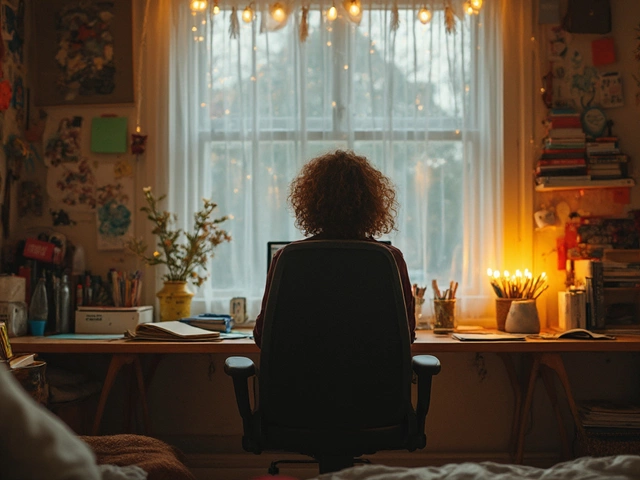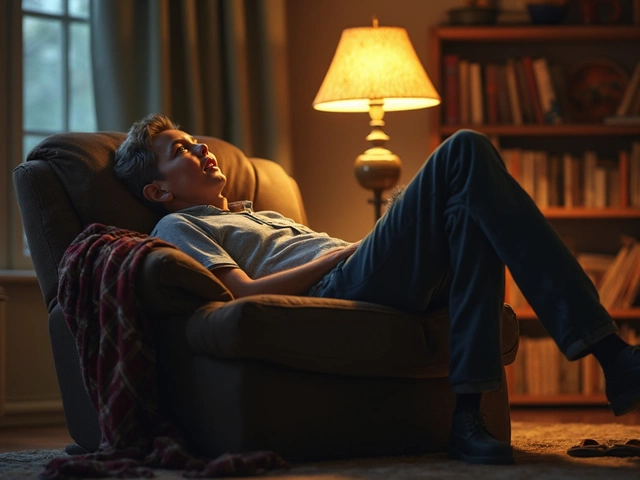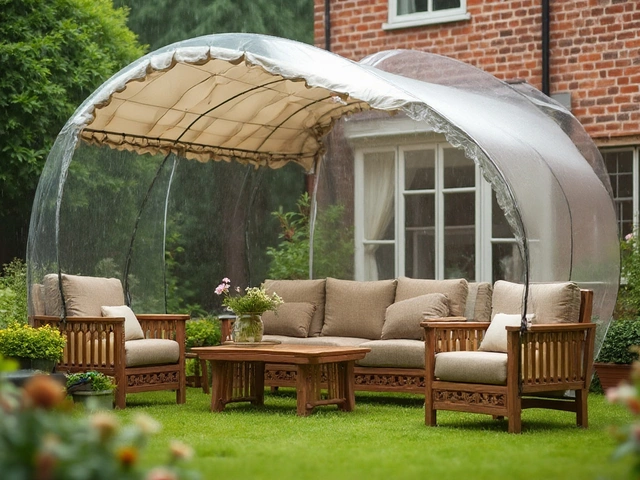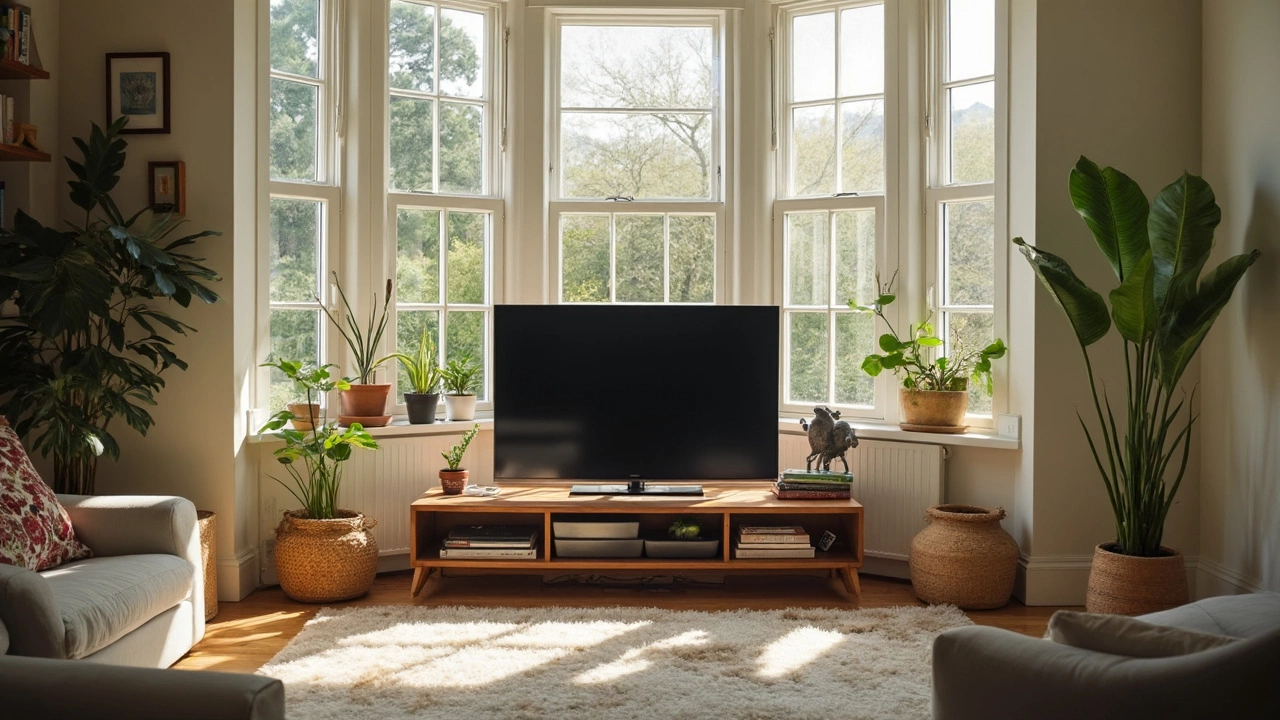 25
Apr,2025
25
Apr,2025
Ever fussed over your TV setup, only to realize it just doesn’t feel right? You’re not alone. Most people plop their screen on a stand without a second thought, but getting the placement right can make a huge difference for comfort—and your eyes.
No one wants to end the night with a stiff neck from looking up or hunching down. So, the rule of thumb? Aim for the middle of your screen to be at eye level when you’re sitting on the couch. Yeah, it sounds geeky, but that’s where your eyes land when you’re relaxed. Grab a measuring tape—this is more useful than you think—and measure from the floor to your seated eye height, then match that to the center of your TV. If your stand’s too high or low, toss a couple of books under your TV or try moving the furniture until it lines up better. Trust me, even a few inches make a difference.
- Finding the Sweet Spot: TV Height
- Distance Matters: How Far Back Should You Sit?
- Keeping It Safe: Stability and Tipping Hazards
- Style vs. Function: Fitting the TV to Your Stand
- Hide the Mess: Managing Cables and Clutter
- Common Mistakes and How to Dodge Them
Finding the Sweet Spot: TV Height
Getting the right height for your TV on a TV stand isn’t just about how it looks—it’s about comfort. Experts usually agree that the center of your TV screen should line up with your eye level when sitting. For most living rooms, that means the middle of the screen should be roughly 42-48 inches from the floor. This lowers neck strain and helps make movie nights more enjoyable.
If you want to be exact, measure the height from your floor to your eyes while seated. Then, measure your TV’s height, divide it by two, and adjust your stand so the TV’s center matches your seated eye height. Here’s a quick breakdown for common TV sizes:
| TV Size (inches) | TV Height (inches) | Eye-Level Position (center from floor) |
|---|---|---|
| 43 | 22 | 42-45 |
| 55 | 27 | 43-48 |
| 65 | 32 | 44-48 |
Notice a trend? Bigger screens mean you might need to lower your stand a bit. It can look odd if it sits too high, and you’re more likely to get glare from lamps or windows. If you’ve got kids running around (like my daughter Orla), keeping the TV lower also means fewer bumped heads and hands tugging at cords.
Don’t forget to factor in the height of your stand itself. Some stands are crazy low; others look more like cabinets. If you can, pick a stand that puts the TV right in the eye-level zone. And if you’re stuck with the stand you’ve got, try raising or lowering your sofa cushions a bit to balance things out.
Bottom line: Line up your TV’s center with your seated eye height, and your neck—and your movie marathons—will thank you.
Distance Matters: How Far Back Should You Sit?
Getting the right distance from your TV stand to your seat isn’t just a matter of preference. It actually makes a difference in how your eyes feel and how clear the picture looks. There’s a pretty straightforward guideline that works for most people and setups.
For high-definition TVs (1080p or above), the best viewing distance is about 1.5 to 2.5 times the size of your TV’s screen, measured on the diagonal. So if you have a 55-inch TV, you’ll want your couch to be roughly 7 to 12 feet away. Ultra HD or 4K TVs can sit a little closer—about 1 to 1.5 times the screen size—because they have more pixels packed in and look sharper up close.
Here’s a quick cheat sheet for ideal viewing distances:
| TV Size (inches) | Min Distance (feet) | Max Distance (feet) |
|---|---|---|
| 43 | 5.5 | 9 |
| 50 | 6.5 | 10.5 |
| 55 | 7 | 12 |
| 65 | 8 | 13.5 |
If you’re sitting too close, you might notice the pixels or start to feel a bit cross-eyed after a long binge session. Too far, and you’ll squint to catch the finer details. If your living room is on the smaller side, consider going for a 4K TV, since those let you sit closer without losing picture quality.
Here’s a quick way to figure things out right now:
- Measure your TV’s diagonal screen size in inches.
- Multiply by 1.5 to get the closest comfy distance (in inches), or 2.5 for the farthest (then divide by 12 to get feet).
- Check if your usual seat hits somewhere in that range.
Playing with these numbers gives you the sweet spot for every movie night. And if you ever ask yourself, “Why does my neck hurt after a few episodes?”—sometimes just moving the couch a bit back or forward makes all the difference.
Keeping It Safe: Stability and Tipping Hazards
This part isn't glamorous, but it could save you money, stress, or even a trip to the ER. TVs, especially the flat ones, can tip over way easier than most people think. According to the Consumer Product Safety Commission, tens of thousands of injuries happen every year just from TVs falling over—which is wild, considering how easy it is to dodge this problem.
The base of your TV stand matters more than you’d guess. Make sure it’s wider and sturdier than the TV itself. If the stand wobbles when you bump it, that’s a red flag. For homes with kids or pets flying around, go the extra mile with some simple safety moves:
- Anchor your TV to the wall using a safety strap or anchor kit. These usually come with simple instructions and don’t cost much.
- Anchor the TV stand itself if it feels light or tippy. Some stands are meant for looks, but not for a busy home.
- Don’t place heavy or tempting stuff (like game consoles or remotes) on top of the TV if little hands might go reaching for them.
- Keep cords tucked away to avoid tripping hazards and accidental pulls. Cable management isn’t just for looks; it’s a safety thing, too.
If you’ve ever seen a TV teeter after someone brushed past it, you know it’s not worth the risk. Some TVs and stands are actually more prone to tipping than others: tall narrow stands, or TVs with small bases, are usual suspects. Here’s a quick snapshot, just to spell it out:
| TV Size | Recommended Stand Width | Stability Tip |
|---|---|---|
| 32" and under | At least TV width | Anchor if used in play areas |
| 33"–55" | 2–3 inches wider than TV on both sides | Always anchor |
| 56" and above | 4–6 inches wider than TV on both sides | Anchor, use anti-tip devices |
If your TV stand didn’t come with an anchor kit, you can grab one online or at a hardware store—don’t skip this step, especially if you’ve got kids like my daughter Orla showing off her ninja moves. You’ll never regret being over-cautious with a TV stand and a big screen.
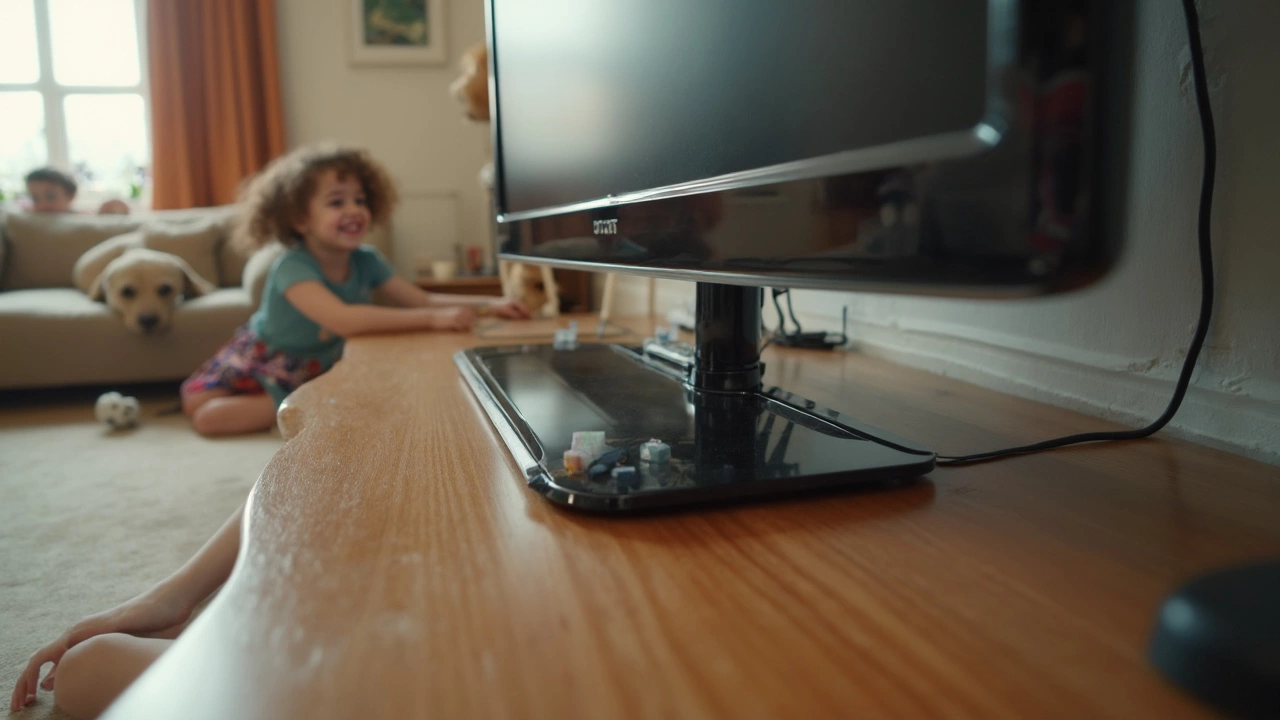
Style vs. Function: Fitting the TV to Your Stand
Picking the right TV stand isn’t just about matching the color to your sofa. One of the biggest mistakes people make is choosing a stand that's either way too small or so massive that it just takes over the whole room. Here's what matters—your TV should never hang off the edge of the stand. Not only does it look awkward, but it’s also a safety risk. Ideally, the stand should be at least two inches wider than your TV on both sides, so measure before you buy.
Let’s talk about weight. Every stand has a weight limit, and ignoring that number is asking for trouble. Today, many modern stands cap out anywhere between 80 to 200 pounds, depending on size and material. That means even some big TVs are fine, but always check the specs twice—especially if you’re tempted by a minimal or glass stand.
Functionality matters too. You want room for soundbars, game consoles, or streaming boxes? Make sure your stand’s shelves actually fit your gear, not just your screen. Shelves that are too narrow make connecting devices or hiding clutter a real headache. Adjustable shelves are a lifesaver if your setup tends to change a lot over time.
If you’re aiming for that clean, “magazine” look, consider stands with built-in cable management. This keeps those snake-like wires tucked out of sight. It also makes cleaning up after kids (or pets) way easier. If your goal is to update the room style from time to time, stick to neutral designs and swap out baskets or decorative boxes instead of the whole unit.
- Always match the stand width to your TV size (at least two inches wider).
- Double-check weight limits; don’t guess.
- Make space for all your gear, not just the TV.
- Look for built-in cable management whenever possible.
- Pick adjustable shelves if your equipment changes.
Real talk—plenty of people end up regretting their stand because it either blocks part of the screen or sits so low their soundbar covers the bottom. Sketch out your setup or use masking tape on the floor to picture how it’ll all fit together before hauling that heavy stand inside.
| TV Size | Recommended Stand Width |
|---|---|
| 50" | At least 54" |
| 65" | At least 69" |
| 75" | At least 79" |
Last thing—don’t let style trick you into ignoring real-life needs. Gorgeous minimalist stands might look great on Instagram, but real living rooms (especially with kids or lots of gadgets) need something sturdy and functional. Find the sweet spot, and your whole setup just works better.
Hide the Mess: Managing Cables and Clutter
Nobody wants to see a tangle of cords behind the TV, especially if you’ve just spent hours picking the perfect TV stand. A messy bunch of wires doesn’t just look bad—it can be a tripping hazard, especially if you’ve got kids running around like my Orla does. Here’s how you can actually keep things tidy without losing your mind.
First things first, use cable management tools. Simple cable clips, Velcro ties, or zip ties work wonders. Loop up any excess cord and bundle it out of sight. You don’t need to drop major cash—hardware stores sell multipacks for less than a sandwich at most places.
If your stand comes with built-in cable holes or channels, use them. Slide cables through so they’re out of view from the front and sides. Even stands without fancy solutions can be upgraded—stick-on cable raceways can hide cords along the back or legs of the stand. The key is to keep them out of common sightlines and away from little hands or curious pets.
If your TV placement means you have to run cords farther—like to a power outlet or external speaker—consider a cord cover. These can often be painted to match your wall, so nothing stands out. Never run cords under rugs, though. That can cause wires to overheat or wear down faster, and it’s honestly a trip hazard waiting to happen.
Don’t forget about devices—game consoles, streaming sticks, soundbars, you name it. Most modern tv stands have shelves or cabinets. Use these to corral gadgets, and feed the cables through holes in the back. If your devices need line-of-sight for remotes, stick them up front, but you can hide the less-used stuff behind closed cabinet doors.
Here’s a quick look at what works for most folks:
- Use cable ties or clips to bundle cords together.
- Thread cables through built-in ports or attach cable raceways to hide visible cords.
- Store devices in shelves or cabinets and run cords through the back.
- Label your plugs—it’ll save time when you need to unplug just the Roku and not the Wi-Fi for the whole house.
If you want the full breakdown for the most popular cable management products, check this comparison before shopping:
| Product | Best For | Average Cost |
|---|---|---|
| Velcro Cable Ties | Bundling cords | $6 (30 pack) |
| Plastic Cable Clips | Securing to TV stand or wall | $8 (40 pack) |
| Stick-On Raceways | Hiding longer cable runs | $15 (per 4 feet) |
Keep your living room design looking sharp and the focus where it belongs: on the screen, not the spaghetti mess underneath it. Tackling the cables only takes a few minutes, but it makes a massive difference.
Common Mistakes and How to Dodge Them
Setting up your TV stand seems simple, but folks run into the same issues over and over again. Want your living room to work for you instead of against you? Here are the classic mistakes people make—and, more importantly, how to sidestep them without any drama.
- TV Too High or Too Low: I’ve seen so many TVs sitting way too high up—sometimes just because the stand looked nice, not because it fit. Remember, the center of your TV should line up with your eyes when you’re chilling on the couch. Not sure where that lands? Most sofas put your head about 42 inches from the floor when seated, so aim for the middle of your TV around there. If your TV is off, grab a cheap adjustable stand, or prop it up temporarily to find your best height.
- Wrong Stand Size: A too-small stand is a recipe for disaster. Your TV’s base needs to fit comfortably, with a couple inches to spare on each side. That’s not just for looks—it keeps accidents (and tip-overs) from happening if someone brushes past. If your TV is bigger than the stand, it’s time to upgrade.
- Bad Viewing Angle: Even the fanciest screen won’t save the day if you’re dealing with glare. Place your TV and stand away from direct windows or lights. Want to go pro? Tilt the screen slightly down toward your spot on the couch to cut down on reflections.
- Letting Cables Go Wild: It’s easy to shove the cords behind the stand and call it done, but tangled wires look messy and create tripping risks, especially for kids. Use clips or a cable box to corral everything. Most modern TV stands even come with cable management sections—worth checking before you buy.
- Not Securing the TV: This one’s huge, especially with kids or clumsy adults around. Around 15,000 Americans wind up in ERs each year for tip-over injuries from TVs and furniture. Always use safety straps or anchor kits to attach your TV to the wall or the back of the stand. A few bucks and 10 minutes now beats a smashed screen or trip to urgent care later.
- Ignoring Viewing Distance: Sitting too close or too far messes with your eyes and the picture quality. For a 55-inch TV, the best distance is about 7 feet away—and not much more. Here’s a quick cheat sheet:
| TV Screen Size | Recommended Distance |
|---|---|
| 43" | 5.5 feet |
| 55" | 7 feet |
| 65" | 8 feet |
Double check your setup with these fixes, and you’re way ahead of the “eh, just stick it there” crowd. Your back, your eyes, and probably your TV will thank you for it.
